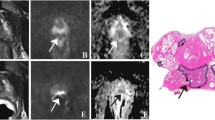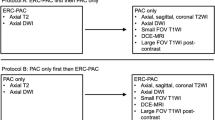Abstract
To compare the visibility of anatomical details and prostate cancer local staging performance of pelvic phased-array coil and integrated endorectal–pelvic phased-array coil MR imaging, with histologic analysis serving as the reference standard. MR imaging was performed in 81 consecutive patients with biopsy-proved prostate cancer, prior to radical prostatectomy, on a 1.5T scanner. T2-weighted fast spin echo images of the prostate were obtained using phased-array coil and endorectal–pelvic phased-array coils. Prospectively, one radiologist, retrospectively, two radiologists and two less experienced radiologists working in consensus, evaluated and scored all endorectal–pelvic phased-array imaging, with regard to visibility of anatomical details and local staging. Receiver operator characteristics (ROC) analysis was performed. Anatomical details of the overall prostate were significantly better evaluated using the endorectal–pelvic phased-array coil setup (P<0.05). The overall local staging accuracy, sensitivity and specificity for the pelvic phased-array coil was 59% (48/81), 56% (20/36) and 62% (28/45), and for the endorectal-pelvic phased-array coils 83% (67/81), 64% (23/36) and 98% (44/45) respectively, for the prospective reader. Accuracy and specificity were significantly better with endorectal–pelvic phased-array coils (P<0.05). The overall staging accuracy, sensitivity and specificity for the retrospective readers were 78–79% (P<0.05), 56–58% and 96%, for the endorectal–pelvic phased-array coils. Area under the ROC curve (Az) was significantly higher for endorectal–pelvic phased-array coils (Az=0.74) compared to pelvic phased-array coil (Az=0.57), for the prospective reader. The use of endorectal–pelvic phased array coils resulted in significant improvement of anatomic details, extracapsular extension accuracy and specificity. Overstaging is reduced significantly with equal sensitivity when an endorectal–pelvic phased-array coil is used.




Similar content being viewed by others
References
Jemal A, Murray T, Ward E et al (2005) Cancer statistics, 2005. CA Cancer J Clin 55:10–30
Steinfeld AD (1992) Questions regarding the treatment of localized prostate cancer. Radiology 184:593–598
Walsh PC, Lepor H (1987) The role of radical prostatectomy in the management of prostatic cancer. Cancer 60(3 suppl):526–537
Sobin LH, Wittekind C (1997) TNM classification of malignant tumours, 5th edn. John Wiley & Sons Inc., New York
Engelbrecht MR, Jager GJ, Laheij RJ, Verbeek AL, Van Lier HJ, Barentsz JO (2002) Local staging of prostate cancer using magnetic resonance imaging: a meta-analysis. Eur Radiol 12:2294–2302
Biondetti PR, Lee JK, Ling D, Catalona WJ (1987) Clinical stage B prostate carcinoma: staging with MR imaging. Radiology 162:325–329
Quint LA, Van Erp JS, Bland PH et al (1991) Carcinoma of the prostate: MR images obtained with body coils do not accurately reflect tumor volume. AJR Am J Roentgenol 156:511–516
Bezzi M, Kressel HY, Allen KS et al (1988) Prostatic carcinoma: staging with MR imaging at 1.5 T. Radiology 169:339–346
Tempany CM, Rahmouni AD, Epstein JI, Walsh PC, Zerhouni EA (1991) Invasion of the neurovascular bundle by prostate cancer: evaluation with MR imaging. Radiology 181:107–112
Schiebler ML, Yankaskas BC, Tempany C et al (1993) MR imaging in adenocarcinoma of the prostate: interobserver variation and efficacy for determining stage C disease. AJR Am J Roentgenol 158:559–562; discussion 563–564
Rifkin MD, Zerhouni EA, Gatsonis CA et al (1990) Comparison of magnetic resonance imaging and ultrasonography in staging early prostate cancer. Results of a multi-institutional cooperative trial. N Engl J Med 323:621–626
Chelsky MJ, Schnall MD, Seidmon EJ, Pollack HM (1993) Use of endorectal surface coil magnetic resonance imaging for local staging of prostate cancer. J Urol 150(2 Pt 1):391–395
Kier R, Wain S, Troiano R (1993) Fast spin-echo MR images of the pelvis obtained with a phased-array coil: value in localizing and staging prostatic cancer. AJR Am J Roentgenol 161:601–606
Outwater EK, Petersen RO, Siegelman ES, Gomella LG, Chernesky CE, Mitchell DG (1994) Prostate carcinoma: assessment of diagnostic criteria for capsular extension onendorectal coil images. Radiology 193:333–339
Quinn SF, Franzini DA, Demlow TA et al (1994) MR imaging of prostate cancer with an endorectal surface coil technique: correlation with whole-mount specimens. Radiology 190:323–327
Tempany CM, Zhou X, Zerhouni EA et al (1994) Staging of prostate cancer: results of radiology diagnostic oncology group project comparison of three MR imaging techniques. Radiology 192:47–54
Hricak H, White S, Vigneron D et al (1994) Carcinoma of the prostate gland: MR imaging with pelvic phased-array coils versus integrated endorectal-pelvic phased-array coils. Radiology 193:703–709
Huch Boni RA, Boner JA, Lutolf UM, Trinkler F, Pestalozzi DM, Krestin GP (1995) Contrast-enhanced endorectal coil MRI in local staging of prostate carcinoma. J Comput Assist Tomogr 19:232–237
Brown G, Macvicar DA, Ayton V, Husband JE (1995) The role of intravenous contrast enhancement in magnetic resonance imaging of prostatic carcinoma. Clin Radiol 50:601–606
Bartolozzi C, Menchi I, Lencioni R et al (1996) Local staging of prostate carcinoma with endorectal coil MRI: correlation with whole-mount radical prostatectomy specimens. Eur Radiol 6:339–345
Perrotti M, Kaufman RP, Jennings TA et al (1996) Endo-rectal coil magnetic resonance imaging in clinically localized prostate cancer: is it accurate? J Urol 156:106–109
Jager GJ, Ruijter ET, van de Kaa CA et al (1996) Local staging of prostate cancer with endorectal MR imaging: correlation with histopathology. AJR Am J Roentgenol 166:845–852
Jager GJ, Ruijter ET, van de Kaa CA et al (1997) Dynamic TurboFLASH subtraction technique for contrast enhanced MR imaging of the prostate: correlation with histopathologic results. Radiology 203:645–652
Yu KK, Hricak H, Alagappan R, Chernoff DM, Bacchetti P, Zaloudek CJ (1997) Detection of extracapsular extension of prostate carcinoma with endorectal and phased-array coil MR imaging: multivariate feature analysis. Radiology 202:697–702
D’Amico AV, Schnall M, Whittington R et al (1998) Endorectal coil magnetic resonance imaging identifies locally advanced prostate cancer in select patients with clinically localized prostate cancer. Urology 51:449–454
Rorvik J, Halvorsen OJ, Albrektsen G, Ersland L, Daehlin L, Haukaas S (1999) MRI with an endorectal coil for staging of clinically localised prostate cancer prior to radical prostatectomy. Eur Radiol 9:29–34
Tsuda K, Yu KK, Coakley FV, Srivastav SK, Scheidler JE, Hricak H (1999) Detection of extracapsular extension of prostate cancer: role of fat suppression endorectal MRI. J Comput Assist Tomogr 23:74–78
Ogura K, Maekawa S, Okubo K et al (2001) Dynamic endorectal magnetic resonance imaging for local staging and detection of neurovascular bundle involvement of prostate cancer: correlation with histopathologuc results. Urology 57:721–726
May F, Treumann T, Dettmar P, Hartung R, Breul J (2001) Limited value of endorectal magnetic resonance imaging and transrectal ultrasonography in the staging of clinically localized prostate cancer. BJU Int 87:66–69
Wang L, Mullerad M, Chen HN et al (2004) Prostate cancer: incremental value of endorectal MR imaging findings for prediction of extracapsular extension. Radiology 232:133–139
Husband JE, Padhani AR, MacVicar AD, Revell P (1998) Magnetic resonance imaging of prostate cancer: comparison of image quality using endorectal and pelvic phased array coils. Clin Radiol 53:673–681
Jager GJ, Severens JL, Thornbury JR, de La Rosette JJ, Ruijs SH, Barentsz JO (2000) Prostate cancer staging: Should MR imaging be used? A decision analytic approach. Radiology 215:445–451
Langlotz C, Schnall M, Pollack H (1995) Staging of prostatic cancer: accuracy of MR imaging. Radiology 194:645–646: discussion 647–648
McCauly TR, McCarthy S, Lange R (1992) Pelvic phased array coil: Image quality assessment for spin-echo MR imaging. Magn Reson Imaging 10:513–522
White S, Hricak H, Forstner R et al (1995) Prostate cancer: effect of postbiopsy hemorrhage on interpretation of MR images. Radiology 195:385–390
Landis JR, Koch GG (1977) The measurement of observer agreement for categorical data. Biometrics 33:159–174
Partin AW, Yoo J, Carter HB et al (1993) The use of prostate specific antigen, clinical stage and Gleason score to predict pathologic stage in men with localized prostate cancer. J Urol 150:110–114
Metz CE (1978) Basic principles of ROC analysis. Semin Nucl Med 8:823
Epstein JI, Carmichael MJ, Pizov G, Walsh PC (1993) Influence of capsular penetration on progression following radical prostatectomy: a study of 196 cases with long-term follow-up. J Urol 150:135–141
Cornud F, Flam T, Chauveinc L et al (2002) Extraprostatic spread of clinically localized prostate cancer: factors predictive of pT3 tumor and of positive endorectal MR imaging examination results. Radiology 224:203–210
Partin AW, Kattan MW, Subong EN et al (1997) Combination of prostate-specific antigen, clinical stage, and Gleason score to predict pathological stage of localized prostate cancer. A multi-institutional update. JAMA 277:1445–1451
Hering F, Rist M, Roth J, Mihatsch M, Rutishauser G (1990) Does microinvasion of the capsule and/or micrometastases in regional lymph nodes influence disease-free survival after radical prostectomy? Br J Urol 66:177–181
Author information
Authors and Affiliations
Corresponding author
Additional information
Financial support: Grant from the Dutch Cancer Society
Rights and permissions
About this article
Cite this article
Fütterer, J.J., Engelbrecht, M.R., Jager, G.J. et al. Prostate cancer: comparison of local staging accuracy of pelvic phased-array coil alone versus integrated endorectal–pelvic phased-array coils. Eur Radiol 17, 1055–1065 (2007). https://doi.org/10.1007/s00330-006-0418-8
Received:
Revised:
Accepted:
Published:
Issue Date:
DOI: https://doi.org/10.1007/s00330-006-0418-8




